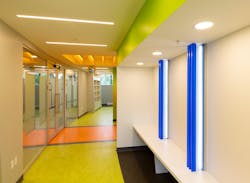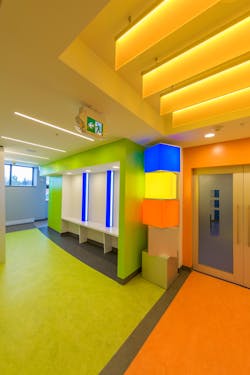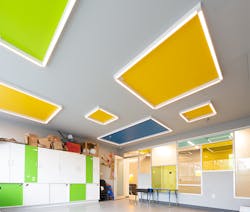SSL IN ACTION | Educational lighting design supports varied special needs
Helping students achieve success and reduce disruptive behavior is critical for schools. Building designs, particularly for those focused exclusively on serving special needs students, must consider sensory challenges and environmental impacts on behavior and learning. Ensuring accessibility of structures and public spaces has become increasingly sophisticated. Understanding students’ unique cognitive and physical disabilities increases their engagement and opportunities for achievement in the educational environment.
To help their developmentally delayed children, Menachem and Devorah Leifer started the Donald Berman Yaldei Developmental Center (Yaldei) in Boisbriand, Quebec in their home with three children and three staff members. Thanks to intensive early intervention treatment, the children demonstrated exemplary progress. Word of mouth about the school’s unique approach led to expansion over the years into numerous facilities since 1998, each larger than the previous.
In 2016, the school purchased a 1960s-era building to accommodate more than 300 students. The three-story building would allow the kids to remain in one facility all day for therapy and school. Separate therapy rooms would be located on the second floor, classrooms and administrative offices on the first floor, and additional classrooms on the third floor. Extensive renovations were needed to accommodate the students’ special needs. In 2017, after a broad search and numerous presentations by architecture firms, the school’s executive board retained Stendel + Reich Architecture Inc.
Planning the built environment
The overall facility design goal was to create a space that would reduce children’s anxiety and make things fun. To help achieve this, Cliff Stendel, associate principal at 50-person firm Stendel + Reich, learned about the different disabilities that the Yaldei Center serves before developing plans to present. Stendel also drew on his previous experience in designing Alzheimer’s facilities to accommodate unique cognitive behaviors. For example, when Alzheimer’s patients get to the end of a corridor they still want to walk straight and don’t realize the need to turn. This also holds true for many Yaldei students. Stendel created oval corridors so the students could easily navigate turns without getting lost.
Color correlation is another key part of the facility design. While many Yaldei students can’t read, they are able to identify colors. For instance, a blue floor tile corresponds with a blue classroom door that is also carried through with hanging blue acoustic ceiling panels.
After observing students in the therapy rooms, Stendel realized they can be easily distracted by outside views and activities. To address this, these rooms no longer have direct windows to the outside but instead feature a glass wall facing the corridor, with windows on the opposite side of the corridor letting in natural light. Since the children can’t see directly outside, they are less prone to distractions.
Getting the light just right
Stendel’s lighting plan had to address varying special needs and developmental issues without creating conflict between them. For example, he needed to consider if a design would work for children who are hypo-sensitive to physical or environmental stimuli while also taking into account hyper-sensitive students. Lighting needed to prevent those who are sensitive to bright lights from being adversely affected and distracted by them while also providing enough illumination to children who require more light. Therefore, Stendel had to identify luminaires with exceptional glare control and lower intensity.
When Montreal-based Axis Lighting learned about the necessary renovations, the company immediately offered luminaires to the Yaldei Center, with which it has a long relationship.
Axis Lighting CEO Howard Yaphe said, “Axis has a long history of philanthropic initiatives and we are honored to help Yaldei School. It is truly heartwarming to know the tremendous impact this school has on children with special needs and their families.”
Axis’ wide range of products provided Stendel the opportunity to specify luminaires that complement the facility design and accommodate a complex ceiling plan. Stendel selected 152 total lights for Phase 1 and Phase 2 of the renovation, which includes Pixel recessed downlights with MikroLite optics that are installed over each classroom door and deliver superior visual comfort and color mixing.
Stendel wanted to avoid using typical 2×4 fluorescent or LED troffers in the classrooms, so he selected skinny strips in various designs. He wanted to ensure that a hyper-sensory child who might be bothered by light would find these fun and less institutional.
Linear luminaires include Edge 2, an ambient LED fixture with a two-sided lens that produces people-friendly vertical illumination for improved facial recognition; the versatile Beam 3; Beam 2 square, a compact linear pendant form with SurroundLite technology that enables generous spacing and high uniformity, resulting in significant energy cost savings with fewer luminaires; and Sculpt linear and pattern.
Finally, the semi-circular Sketch fixture mimics the curve of the circular entrance ramp while delivering comfortable and efficient illumination.
Promising results
“Considering the design objectives, Axis luminaires helped create a good balance of not over- or under-lighting the rooms. The lighting also played an important role in helping keep the facility’s atmosphere fun for the students,” Stendel said.
Yaldei therapists have commented on the therapeutic advantages of RGB lights that are installed in some rooms. For example, if kids are getting distracted while looking outside, the color of the lights can be changed to redirect the students.
The center believes the design’s consistent use of details, colors, and themes helps reduce children’s anxiety and agitation. Adhering to this principle, the lighting’s shapes and angles are the same throughout the building, providing familiarity and comfort.
In harmony with the architectural and interior design, the lights enhance the spaces and create a nurturing, playful environment.
“Axis was extremely sensitive to the unique needs of this project and we are extremely grateful for their donation and ongoing support,” said Menahem Leifer, CEO of Yaldei.
For continuity and to support the students’ needs, the third-floor classroom design is the same as the other two floors, and also includes donated LED luminaires from Axis Lighting. The final phase of the school’s construction was completed in the fall, with a total renovation cost of $4.5 million. The third-floor renovations enabled Yaldei to accept more students to due to its expansion with MEP and HVAC equipment that supports eight new classrooms, each with a kitchenette; an additional accessible restroom; a teacher resource room; and a new library. School administrators plan to adapt additional rooms into fully equipped classrooms to meet growing demand for placements. Yaldei has seen a 20% increase in students as a result of its reputation for evolving to meet student needs with its long-term renovation plans.
Project notebook
Lighting design/specification – Cliff Stendel, Stendel + Reich Architecture Inc.
Electrical & lighting installation – Jaco Electrique Inc.
Lighting manufacturer – Axis Lighting
Structural engineer: SBSA
General contractor: Clobracon (Phase 1), Javad Moradi-Propers Construction (Phase 2)
Get to know our expert
MICHELE BARTOLINI, senior marketing director of Canada-based Axis Lighting, has more than 25 years of marketing experience in a variety of industries. Prior to joining Axis Lighting, Bartolini held marketing leadership positions at Sustana and Rolland Fine Papers implementing strategies to drive the brand and meet measurable business objectives. Axis Lighting has received several awards for architectural SSL products, including an LEDs Magazine Sapphire Award for Sculpt Accent luminaires in 2017 and a BrightStar Award for StencilFlex in 2022.
For up-to-the-minute LED and SSL updates, follow us on Twitter. You’ll find curated content and commentary, as well as information on industry events, webcasts, and surveys on our LinkedIn page and our Facebook page.








